Coming Soon To Volleyball Courts EVERYWHERE!
Sandy Pickle XL is a modified version of the original game, with adjustments made specifically for playing a versatile new version of pickleball on existing volleyball courts.
Volleyball is actually one of the most widely played sports on the planet, which is why it’s quite common for most schools, and many public parks and beaches to come equipped with volleyball courts. And, while competition for pickleball courts has become borderline ridiculous, finding an open volleyball court is usually quite easy once you start looking for them.
See below for a complete description of how the standard Sandy Pickle rules have been modified to accommodate for the larger dimensions and taller net heights found on beach and traditional volleyball courts.
Sandy Pickle XL Details & Rules
1. Court Dimensions:
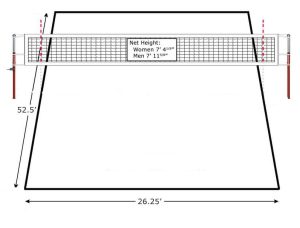
In the original game of Sandy Pickle, a singles court width is 13′ 6″ (4.1 meters), and doubles is 16′ 8″ (5.1 meters), with baselines at 16′ for singles and 18′ for doubles. Each half of a standard beach volleyball court is approximately 10′ wider and 8′ longer than a Sandy Pickle doubles court (and even a bit more for standard indoor courts). As detailed more below, this larger court area allows for 3 and 4 person teams, and optionally, can be modified for doubles and singles according to how much players want to challenge themselves.
2. Net Height
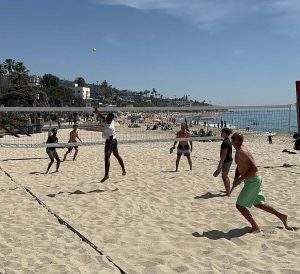 In Sandy Pickle, the net should be set to the approximate height of the tallest player on the court, thus minimizing the spiking advantage of taller players. On existing volleyball courts, the net height is typically set at 7′ 11 5/8″ for men and 7′ 4 1/8″ for women, which at either height significantly changes the ability to have a real spiking advantage, which is why as you’ll see below, in Sandy Pickle XL the “No Spike Zone” (a.k.a. Kitchen) has been eliminated.
In Sandy Pickle, the net should be set to the approximate height of the tallest player on the court, thus minimizing the spiking advantage of taller players. On existing volleyball courts, the net height is typically set at 7′ 11 5/8″ for men and 7′ 4 1/8″ for women, which at either height significantly changes the ability to have a real spiking advantage, which is why as you’ll see below, in Sandy Pickle XL the “No Spike Zone” (a.k.a. Kitchen) has been eliminated.
3. NO No-Spike Zone
In the original Sandy Pickle, the area within 5’ of the net on each side is called the “No Spike Zone” (similar to the “Kitchen” in pickleball). The reason for this is to eliminate poaching and otherwise taking advantage of an easy kill shot or spike.
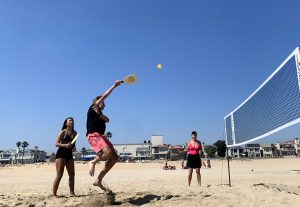
With the net height being in excess of 7 feet high (and nearly 8′ on some courts), there is no need to restrict the area. While it is possible to “poach” in Sandy Pickle XL by playing close to the net, it is also much easier for the players on the other side to simply lob shots over the defender. After testing the game both with and without a no-spike zone, it became clear that less is more, and therefore in this version of the game this line has been eliminated.
4. One Pass, or “BUMP”
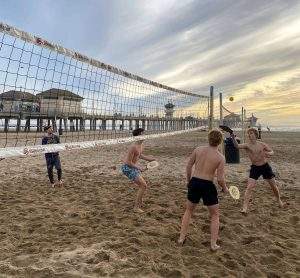
Just as in the original game, Sandy Pickle XL allows for up to two touches per side. We did try the idea of following the volleyball “Bump – Set – Spike” three touch sequence, but found it actually made spiking a bit too easy with that extra touch, so we settled back on our original rules.
*Note that the 1-pass rule does not apply to singles play.
5. From 1 to 4 Players Per Team
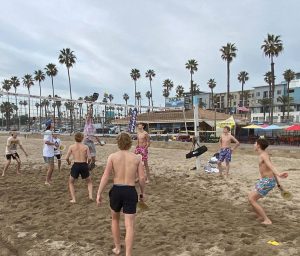
By taking Sandy Pickle to a larger playing area, the XL version of the game offers the flexibility to include more players.
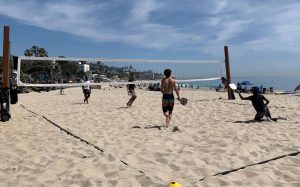
In singles and doubles, the court area can be more physically demanding than many recreational players would prefer, which is why rules allow for reducing the court width. For singles, 15′ wide and 15′ deep is the most popular adjustment, and 20′ x 20′ for doubles. Teams of 3 and 4 should utilize the existing volleyball boundaries.
Video Examples:
Doubles
3 on 3
4 on 4
6. Positions
 Other than the requirement that the player serving is behind the right half of the end line, teams are allowed to arrange themselves however they choose.
Other than the requirement that the player serving is behind the right half of the end line, teams are allowed to arrange themselves however they choose.
In doubles, the standard formation is right/left, but some teams prefer to play short/deep.
Three-person teams usually play two short (left and right) and one deep, rotating clockwise each time the serve returns to their side of the court, and four-person teams almost always play two short and two deep, each covering their 1/4 of the court, although three up and one back can be an effective way to control the net!
7. Serving
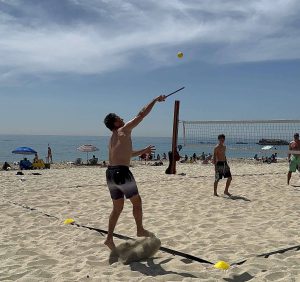 Serves are made from behind the baseline on the right hand half of the court (similar to volleyball) with no limitations as to which side of the court the serve is hit to. Teammates rotate positions when the serve returns to their side after winning a defensive side-out.
Serves are made from behind the baseline on the right hand half of the court (similar to volleyball) with no limitations as to which side of the court the serve is hit to. Teammates rotate positions when the serve returns to their side after winning a defensive side-out.
The player serving continues until they lose a point, after which the opposing team takes over the serve (in Sandy Pickle the serve alternates sides at the end of each players serving opportunity, unlike pickleball in which both teammates serve before a side-out).
Also unlike pickleball, players may serve overhead, underhand, backhand, sidearm or otherwise so long as they serve from behind the baseline and the ball makes it over the net, beyond the no-spike zone, and within the boundaries. A serve is “out” if it lands outside court boundaries. If the ball hits the net but lands within the boundaries, or hits a boundary line, it is considered “in” (similar to pickleball).
8. Scoring
Like pickleball, games are played to 11 points and must be won by 2 (or more). A point is earned when the player or team serving wins the point. If the player or team RECEIVING the serve wins the point, they take over the serve but no point is awarded.

A complete set is the best of 3 games, with teams switching sides after each of the first two games, and then every 5 points if there is a third game (i.e. 3-2, 7-3, 10-5, etc).
Scoring Note: When a team is winning 7-6, for example, the player serving would call out “7-6” rather than “7-6-1” as in pickleball where both players serve before a side-out. For experienced pickleball players, three-digit scoring calls are routine; for most of everyone else, the confusion warranted simplification in the official Sandy Pickle rules.
SANDY PICKLE XL RULES BULLET POINTS
Number of Players, Equipment & Court Dimensions
- Whether playing on a standard beach volleyball or indoor court, the boundaries are larger and the net is higher than in the original Sandy Pickle game, allowing for up to 4 players per side.
- As in Sandy Pickle, any standard pickleball paddle may be used; the ball may be a standard outdoor or indoor pickleball (depending on court location).
- For singles play, boundaries should be shortened in both length and width to 20’ x 20’ on each side (use boundary cones or line markers included with your Sandy Pickle set).
- Doubles teams MAY reduce the boundaries by 5 feet in both length and width on each side.
- When playing three and four players per side, use standard volleyball boundaries.
- There is no “Kitchen” or “No Spike Zone” in Sandy Pickle XL due to a much higher net than in the original game. It is recommended that players use the existing net height on public volleyball courts. For adjustable height nets, a minimum height of 7’ is recommended.
SERVING & ROTATION
- Serves must be hit from behind the baseline on the right hand-side of baseline center.
- Overhead, underhand, and sidearm serving styles are all legal.
- There is no limitation as to which side of the court the serve may be hit to.
- The non-serving partner(s) start each serve on the left half of the court(doubles), front left and right halves (three players), or back-left, and front left and right halves (four players). The server continues until they lose a point, after which the opposing team takes over the serve.
- Teammates rotate clockwise when the serve returns to their side after winning a defensive side-out (front right rotates to server).
SCORING
- Games are played to 11 points and must be won by 2 (or more).
- A point is earned only when the player or team serving wins the point.
- If the player or team receiving the serve wins the point, they take over the serve but no point is awarded (side-out).
ONE PASS, OR “BUMP”
- Players may pass or “bump” the ball to their teammate; the following hit must be over the net.
OTHER
- A ball hitting a boundary line marker is “in”.
- If the ball hits the net on the serve and remains inside the boundaries, it is playable.
- If a player’s body or paddle reaches over or touches the net, it is a fault and the point is lost.
- When serving, a player may jump forward but may not touch the ground inside the baseline until after the paddle has made contact with the ball.


